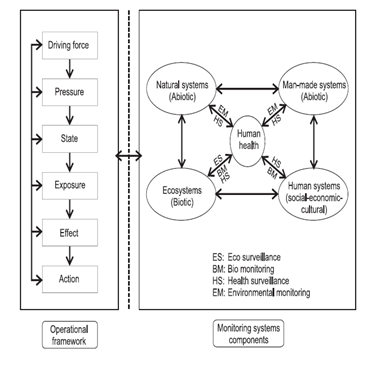Conceptual framework for integrated monitoring
- The text on this page is taken from an equivalent page of the IEHIAS-project.
The detail information for this framework is given in D64.1-Revised integrated monitoring report. It is available on INTARESE-website.
What components should be measured in the integrated monitoring programs? Based upon this question, we have developed a conceptual framework for integrated monitoring, namely Integrated Environment and Health Monitoring (IEHM) framework.
Concepts and principles
Building on DPSEEA (Driving Force-Pressure-State-Exposure-Effects-Action) framework [1], INTARESE project goal and integrated monitoring concept (D51 and D64.1), we propose an integrated environment and health monitoring (IEHM) framework to explain what components an integrated environment and health monitoring should include. Accordingly, we define integrated environment and health monitoring as an ongoing and systematic process to determine, analyze and interpret environmental quality and environment-related health status.
The IEHM framework (Figure 1) presented here is based upon four related principles that demonstrate how natural systems, man-made systems, ecosystems and human systems interact across an integrated monitoring system.
- Monitoring entire systems rather than their individual components.
- Addressing the spatial and time dimensions.
- Monitoring processes, not static elements.
- Keeping the end goal of assisting decision making in mind.
Operational framework and main components
The operational framework of IEHM addresses the principle of monitoring process, not only static elements in order to identify the casual links, and at the end assist decision-making. It should cover the main media from driving sources, pressure, state, exposure, effects to action.
Driving forces component refers to the factors that motivate and push the environmental processes involved. These result in the generation of pressures on the environment. In response to the pressures, the state of the environment is often modified. Deterioration in the state of the environment, however, poses risks to human well-being only when there is interplay between people and the hazards in the environment.
Exposure is therefore rarely an automatic consequence of the existence of a hazard: it requires that people are present both at the place and at the time that the hazard occurs. Exposure to environmental hazards, in turn, leads to a wide spectrum of health effects, which may be acute or chronic. Some hazards may have a rapid effect following exposure, whereas others may require a long time to produce an adverse health effect. The concept of exposure is best developed in relation to pollutants in environmental media. The amount of the pollutant absorbed, i.e. the "dose", depends on the duration and intensity of the exposure.
In face of the environmental problems and consequent health effects, society attempts to adopt and implement a range of actions. These may take many forms and be targeted at different points within the environment–health continuum. Actions may be taken to reduce or control the hazards concerned, such as by limiting emissions of pollutants or introducing flood control measures. The most effective long-term actions, however, are those that are preventive in approach, aimed at eliminating or reducing the forces that drive the system.
The main components of IEHM framework are:
- natural system refers to physical environment. It includes physical phenomena that lack clear-cut boundaries, such as air, water, and climate, as well as energy, food, radiation, electric charge, and magnetism, not originating from human activity;
- man-made system comprises the areas and components that are strongly influenced by human being. It includes physical structures, public infrastructure, parks, man-made lakes, mines and rock quarries;
- Ecosystem refers to the ecological setting, universal resources, ecosystem goods and services. The key components are complete ecological units that function as natural systems without massive human intervention, including all vegetation, animals, microorganisms, rocks, atmosphere and natural phenomena that occur within their boundaries; and
- human system is separated between social-cultural, economic and institutional aspects. Social-cultural aspects include culture, demography, social infrastructure, knowledge, social interactions, social environment, and life style, etc. Economic aspects include economic infrastructure, economic development, and trade, etc. Institutional aspects include institutional infrastructure, health policy, health-related policy, health services, etc.
With integrated monitoring concept in mind, keeping human health in the centre of IEHM framework, there are interconnections between the main components of IEHM framework.
- Environmental monitoring and health surveillance are relevant between natural system and human health.
- Environmental monitoring and health surveillance are relevant between man-made system and human health.
- Environmental monitoring, biomonitoring and health surveillance are relevant between ecosystem and human health.
- Biomonitoring and health surveillance are relevant between human system and human health.
